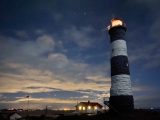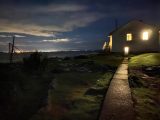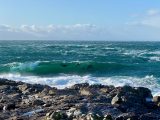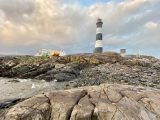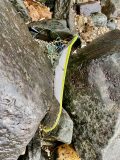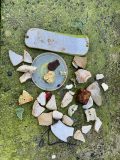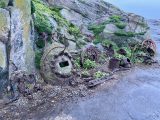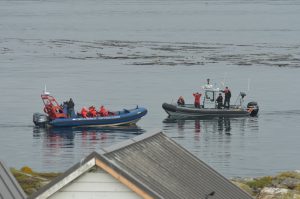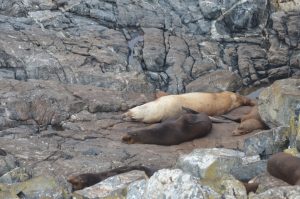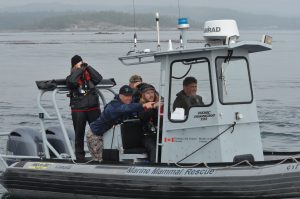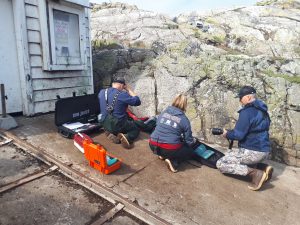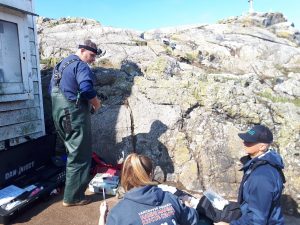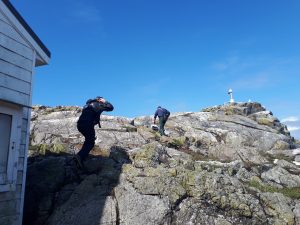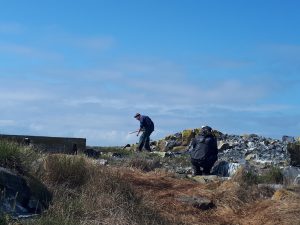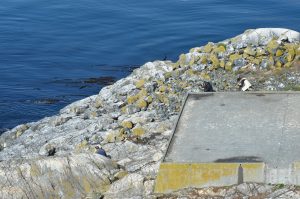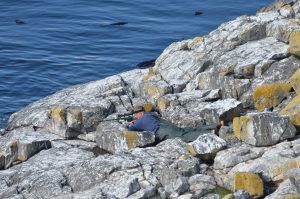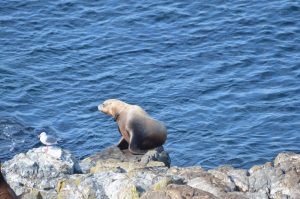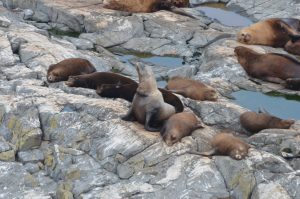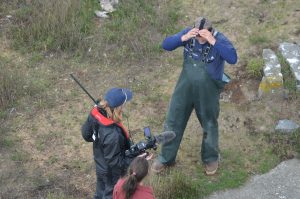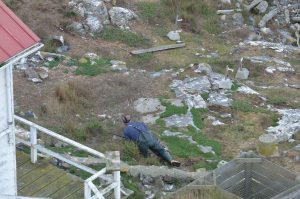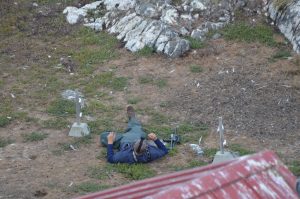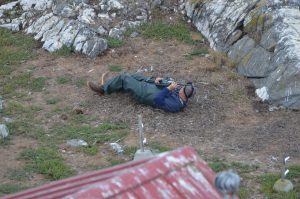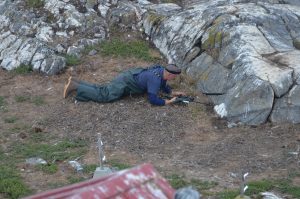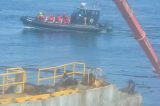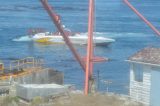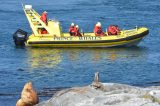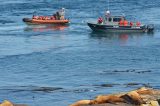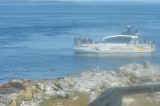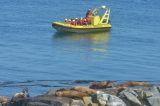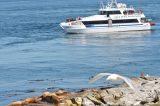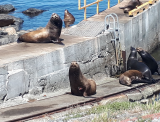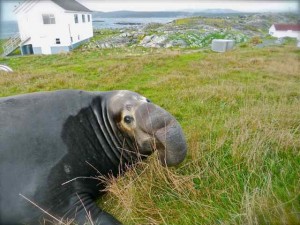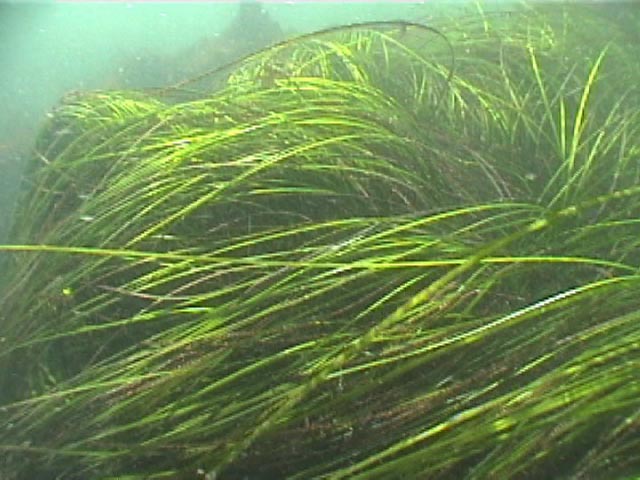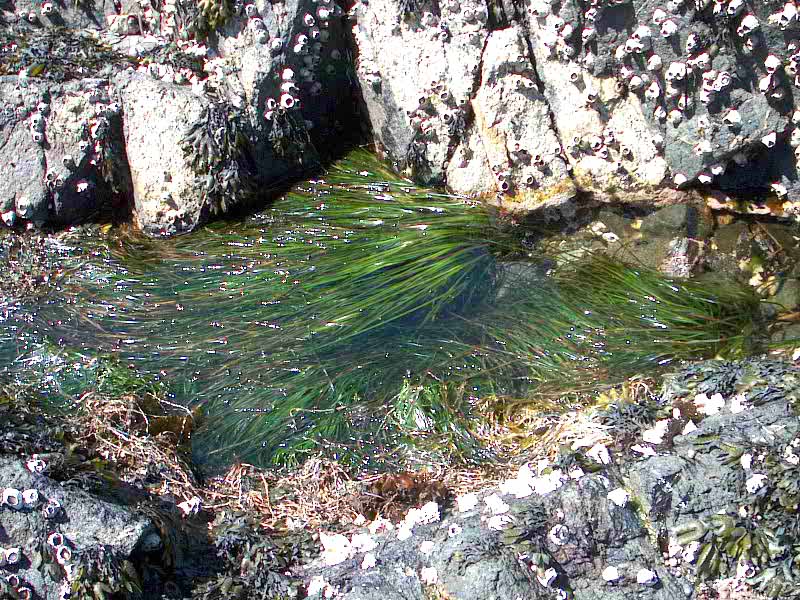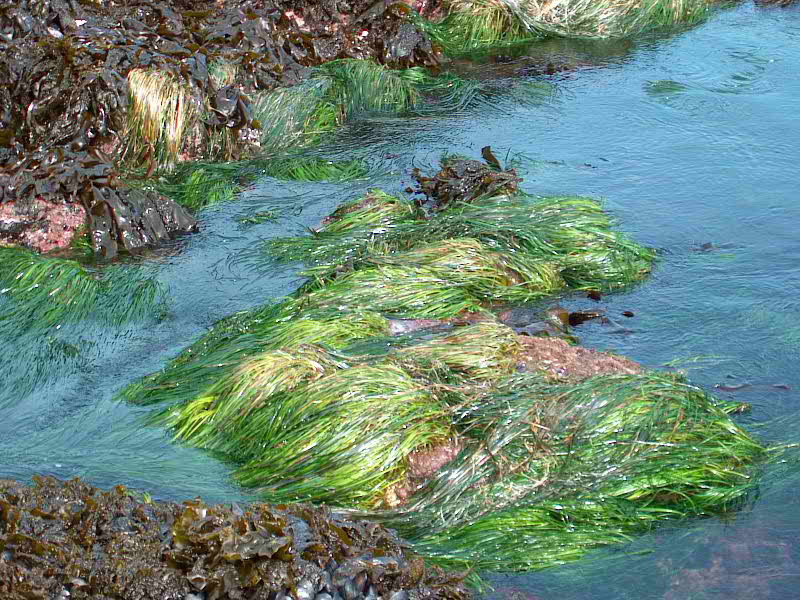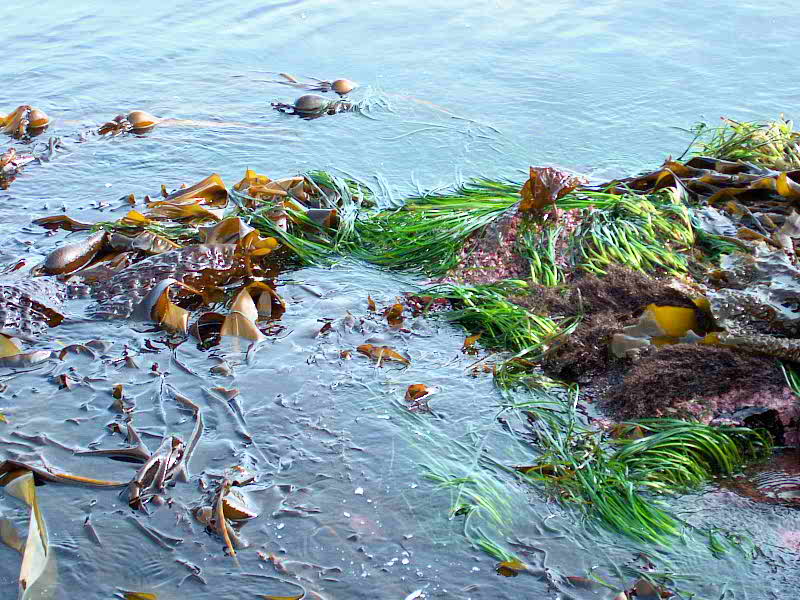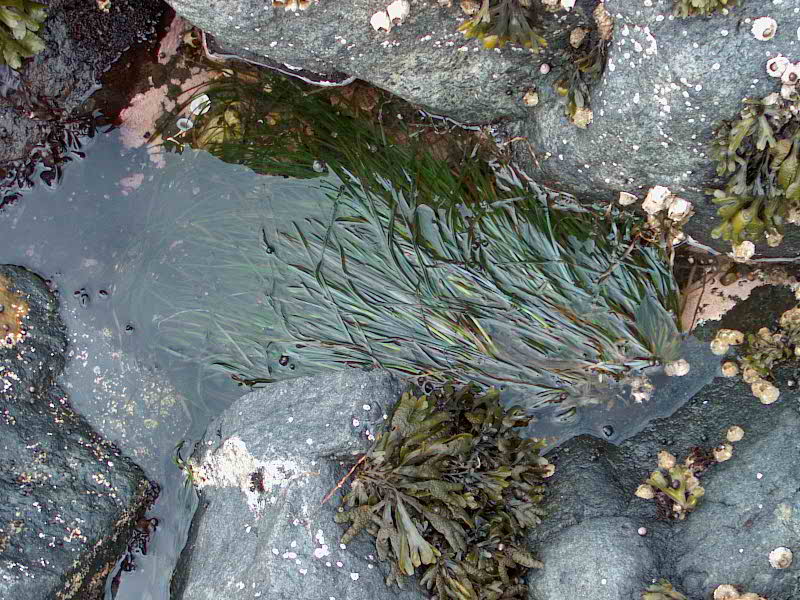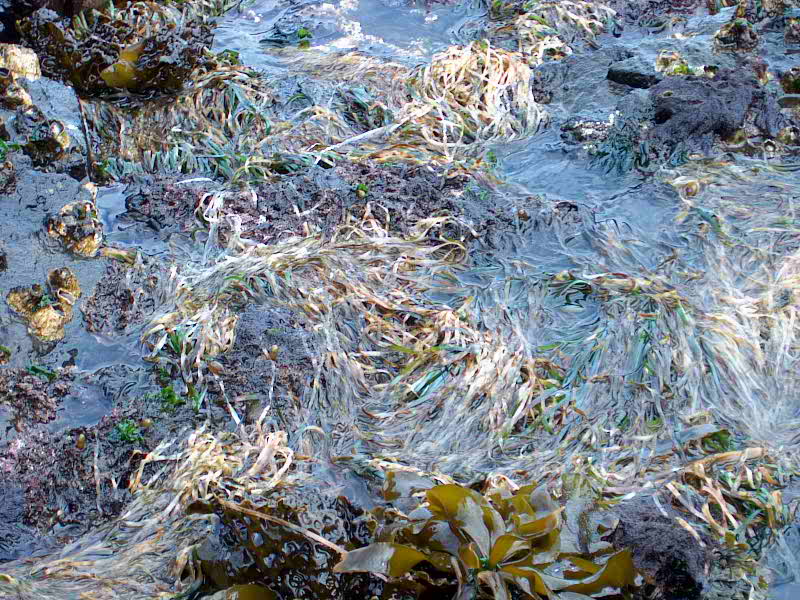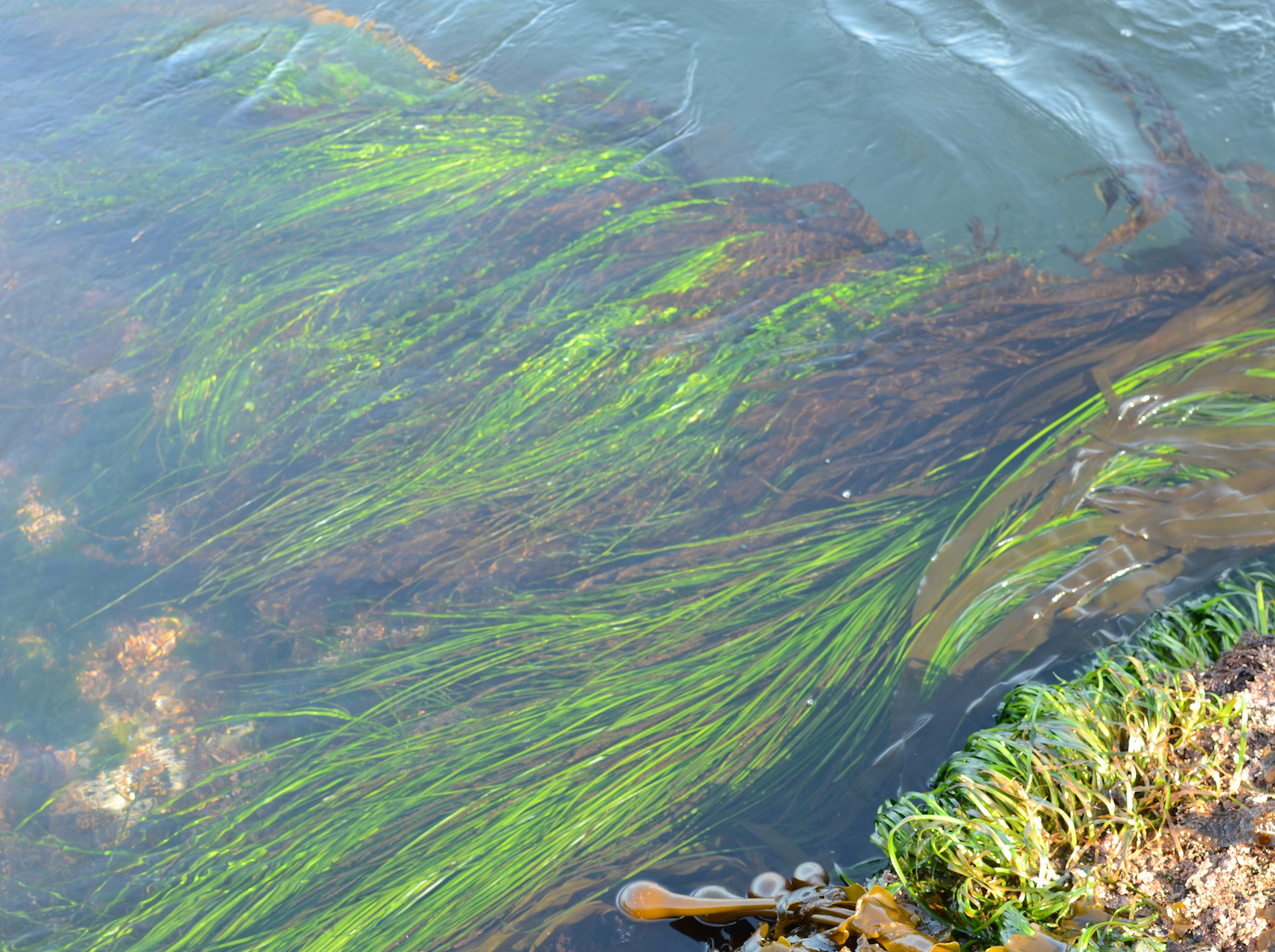Tag Archives: video
Stormy Sunday
Wind: 3-52 knots swinging around from SW yesterday in every direction to NW this evening
Sea State: up to 4 m waves
Visibility: 5-15 NM
Sky: overcast with rain and some sunny patches
Temperature: 5-8 °C
Atmospheric CO2: 413.65 ppm (recorded by NOAA at Mauna Loa Observatory, Hawaii)
It has continued be very windy over the past two days, whipping up big waves from the west. Today, the wind reached a top speed of 54 knots or 100 km/h, which on the Beaufort Wind Scale is force 10, corresponding to a storm. The two higher forces on the scale are 11 (56-62 knots violent storm) and 12 (64-71 knots hurricane). See the photos and videos below for some windy and wavy views.
The wind cleared off the South Seal Rocks of its usual inhabitants of steller sea lions. They were floating in sea lion rafts and surfing the waves for most of the day. When the wind died down a bit in the late afternoon, I walked in the intertidal zone which at low tide connects the main island with the closest of the South Seal Rocks. I hadn’t been able to walk around there in the past two weeks I have been here, due to the hauled out sea lions. It was great to see the main island from the perspective of a sea lion. On my walk around, I found some intertidal trash, some of which has been there for a while. See the photos below for some of my finds.
On Monday, there is a planned visit from some electricians and technicians to do some work on the desalinator and energy system. These will be the first visitors in a week and a half. If all goes according to plan, the desalinator will be operational by early afternoon and pumping water into the tank.
During my time here in the past two weeks, I have used 800 L of water, according to the gauge on the water tank as well as the three consumed drinking water jugs. While I’m conscious of my water use, I still do all the normal tasks like cooking, drinking lots of tea, washing dishes, showering and doing laundry. As a comparison, the 2018 average day per capita water use in Vancouver, BC was 444 L. I’m doing all right!
- The bright moon last night offered a great view of the lighthouse and ecoguardian’s house
- My walk back to the house in the evening after turning off the generator. The bright lights in the distance are Esquilmalt and Victoria.
- Sea lions swimming through the waves
- A rare sea lion’s view from South Seal Rocks of the energy building, lighthouse and fog horn.
- Large fishing lure wedged between rocks in the intertidal zone
- Intertidal trash finds: fishing lure, glass, ceramic, metal, plastic
- Rusted metal found in the intertidal zone
- I moved my metal finds up onto the island with the other remnants of the old engine room.
Video: A panoramic view of the whole island and waves as seen from helicopter pad. The sound is quite loud due to the strong wind.
Video: Watching hail on the window from the comfort of inside the house, while the elephant seal neighbours brave the elements outside. It hailed three times today.
Sea Lion Rescued from Plastic Entanglement
A team comprised of the DFO and Vancouver Aquariums Marine Mammal Rescue (MMR) came out to Race Rocks on September 16th to help the entangled sea lions we’ve spotted over the last few weeks. Leaving from Pedder Bay at 0900, they arrived in two RHIBs at the reserve shortly after. After observing the struggling animals over the last while and communicating information with MMR, they were a welcomed sight.
- MMR and DFO arrive at the edge of the reserve.
- An eco tourism boat encounters the DFO support vessel in front of the jetty.
Right away we spotted three possibly entangled sea lions from the lighthouse (unfortunately none of these three being the animals we photographed previously). We then landed the team of vet techs and veterinarian Marty at the jetty to assess the situation. It was decided that one of the sea lions resting by the water between the guest house and the helicopter pad was our best rescue candidate.
- The entangled sea lion.
- Visual contact from the water!
Marty and a videographer from Vancouver Aquarium approached over the helicopter pad from the direction of ‘Camera 5’. They got into position and a shot was taken, but the tranquilizer dart bounced and the sea lion fled into the water.
- Preparing the tranquilizer.
- The sea lion was estimated to weigh 500kg, and the dose had to be measured accordingly.
- (1) Heading towards the helicopter pad.
- (2)
- Marty gets into position below the helicopter pad.
- Lining up the shot with the tranquilizer gun.
- (1) Another angle of the sea lion
- (2)
From the lighthouse we were able to follow its movements and keep the team apprised by radio. There was uncertainty about whether or not it received a partial dose of the tranquilizer as it floated in strange positions/patterns. Moving around Race Rocks to the water beside the solar panel/generator building, it hauled out again and another shot at it was lined up from one of the boats. The angle wasn’t quite right, and it again fled into the ocean and couldn’t be spotted. It was around 1400, and everyone took a break to have some food.
After this, everyone considered calling it off as it was getting late and we couldn’t locate the animal. At the last moment, with both boats ready to head back to Pedder Bay, it was spotted from the lighthouse (resting on the rock mound on the NW point of Great Race Rock)! Tranquilizing was attempted from water, but the dart bounced again and landed in the water and was recovered. Here’s a short video of that:
After that, it ended up too far from the water to try another shot by boat, so in a final effort the one boat landed Marty and the team again while the other stayed on the water to support. With no cover available between him and the animal, Marty had no choice but to crawl about one hundred feet in order to take the shot.
- The sea lion is sighted again on the point of NW Race Rock.
- MMR team gets back onto land.
- Gearing up for the land approach. Hopefully some good video was captured!
- Marty moves over challenging terrain near our compost bins, staying low while managing to carry the large tranquilizer gun.
- (1) The electric fence was off, but it still was an obstacle as standing would have frightened the surrounding sea lions into the ocean!
- (2)
- (3)
We were able to capture the following footage of the sea lion being darted, going into the water, and then after a tense 20 minutes during which a pod of transient orcas appeared in the reserve (who sometimes eat sea lions), it was found! The team proceeded to cradle the animal between their vessels and remove the plastic band. Then, they injected a reversal drug to reverse the tranquilizer before letting it go.
Everyone was relieved to have successfully helped an animal in need. We have suggested that future disentanglement efforts might have a better chance if extended to overnight stays in the guest house, and perhaps coordinated and executed in a more timely manner in relation to the animal sighting(s). This time we were unable to find the original animals that we had previously spotted, since it took quite a while to organize the rescue attempt. A big thank you to everyone who came to help this sea lion and teach us about their work!
Check out rescue.ocean.org to learn more about the Vancouver Aquarium Marine Mammal Rescue program, and Ocean Wise.
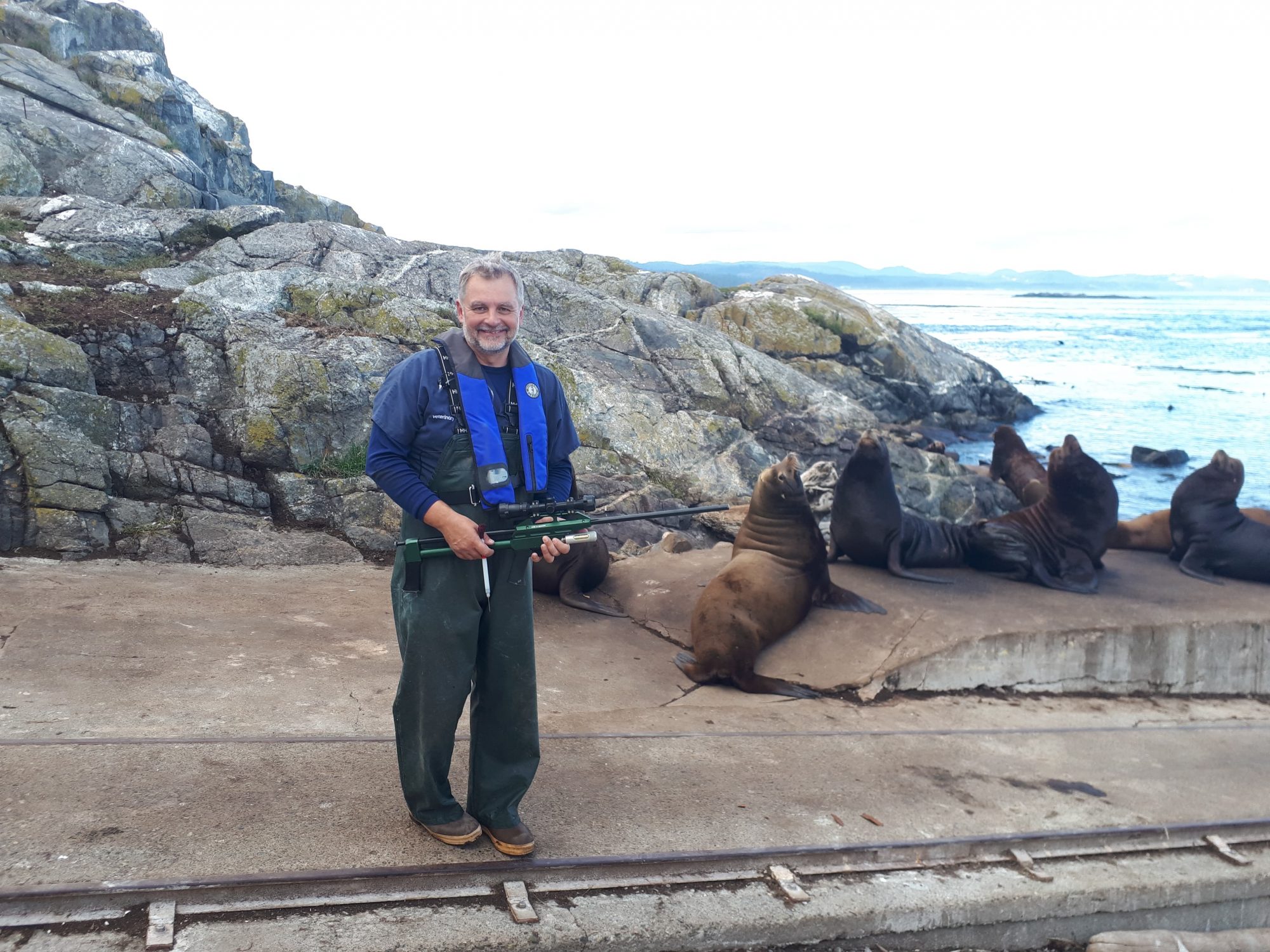
Thanks to the rescue team, one more sea lion has a better chance of survival! (vet Marty holding the dart gun and dart used to tranquilize the sea lion)
See media coverage: https://www.bclocalnews.com/news/plastic-band-removed-from-neck-of-greater-victoria-sea-lion-2/
A Busy Day On The Water
Weather:
- Blue skies, some clouds
- Visibility 20+ miles
- Wind 5-10 knots W
- Water rippled
Boats/Visitors:
- Many whale watching vessels today. With the increasing number of sea lions hauling out on great race rock, these eco tourism boats contrast sharply (in relatively close quarters) against the wildlife looking to rest on the rocks.
- The high traffic in conjunction with the sea lions provides a great opportunity to display the proximity of these vessels from the wildlife. See the videos and photos below:
Ecological:
- An increasing number of sea lions hauling out on all rocks.
- Young seagulls can be seen strengthening their wings, flapping and hopping 3 feet in the air. They play games with sticks and other debris, aggressively keeping the objects from their siblings looks to be practice for protecting precious food in the future.
- Mentioned in a previous post, I was able to get a picture of the sea lion with the identifying gash in its side.
Census:
- 350 – 400 seagulls
- 24 harbour seals
- 68 sea lions
- A handful of oystercatchers and cormorants (roughly 5-10 of each)
Race Rocks Ecological Reserve -Video
Elephant Seals: up close and personal video
Mike Robinson took this video of Misery today:
Get up close and personal with a Northern Elephant Seal at Race Rocks Ecological Reserve. Lots of facts and personal observations of these magnificent marine mammals, the second largest carnivore on the planet after their Southern cousins.
David Attenborough did this in depth video of Elephant Seals from Elephant Seals /Life in the Freezer/ BBC earth
Also this video Elephant sealls of Piedras Blacas , California by Brian Caserio iis very informative.
Pelican and Elephants Seals
The big adult male elephant seal (Mirounga angustirostris) is back from a few days excursion. Misery is looking sleek and healthy. The small female looks to be improving. The redness of her wounded eye is diminishing.
| Pelecanus occidentalis observed at Race Rocks |
Phyllospadix scouleri: surf grass– Race Rocks taxonomy
- P. scouleri growing subtidally off the western shore of Race Rocks
- P. scouleri in a tide pool on the western shore of Race Rocks
- Clumps of P. scouleri with Hedophyllum
- P. scouleri with Hedophyllum and Nereocystis at the low-tide mark
- P. scouleri in a tide pool
- P. scouleri at the low-tide mark
- Phylospadix scouleri, also known as surf grass is found in the low tide zone and the top of the sub-tidal. Here it is mixed with Desmarestia aculeata and bull kelp Nereocystis lutkeaena both subtidal species.
Domain: Eukarya
Kingdom: Plantae
Clade: Tracheophytes
Clade: Angiosperms
Clade: Monocots
Order: Alismatales
Family: Zosteraceae
Genus: Phyllospadix
Species: P. scouleri
Binomial name
Phyllospadix scouleri
Genus/species Phyllospadix scouleri (Hooker)
Description: This flowering plant is most characteristic of the open rocky shores of the coast that are exposed to the full force of the waves, as on the west coast of Vancouver Island. There it forms bright emerald-green beds on the rocks near extreme low-tide level. The plants are relatively short, usually not more than a metre in length, and the leaves are 20-32 mm. wide. Short basal flowering stems are produced, which are 5-8 cm. long.
Habitat: On rocks in the lower intertidal and upper subtidal zones.
Pacific Coast Distribution: Alaska to Mexico.
Robert Scagel, 1972
|
|
and Image File |
 The Race Rocks taxonomy is a collaborative venture originally started with the Biology and Environmental Systems students of Lester Pearson College UWC. It now also has contributions added by Faculty, Staff, Volunteers and Observers on the remote control webcams. March 8 2009- Ryan Murphy The Race Rocks taxonomy is a collaborative venture originally started with the Biology and Environmental Systems students of Lester Pearson College UWC. It now also has contributions added by Faculty, Staff, Volunteers and Observers on the remote control webcams. March 8 2009- Ryan Murphy |
Bad Hair day for the Eagles
Pam Birley has a special skill of capturing the unusual events at Race Rocks. The winter provides her with opportunities to se the Bald Eagles in various moods.
Invertebrate Phyla at Race Rocks
“Invertebrate Phyla at Race Rocks” is an introductory piece on some of the invertebrate phyla that our divers encounter underwater . This was one of the first streaming videos done by the Pearson College divers in April 2000. It was taken by Rowena and Shamsher on a Sony Digital camera, and edited by Hannah and Garry on a G4 Macintosh Computer using iMovie.


